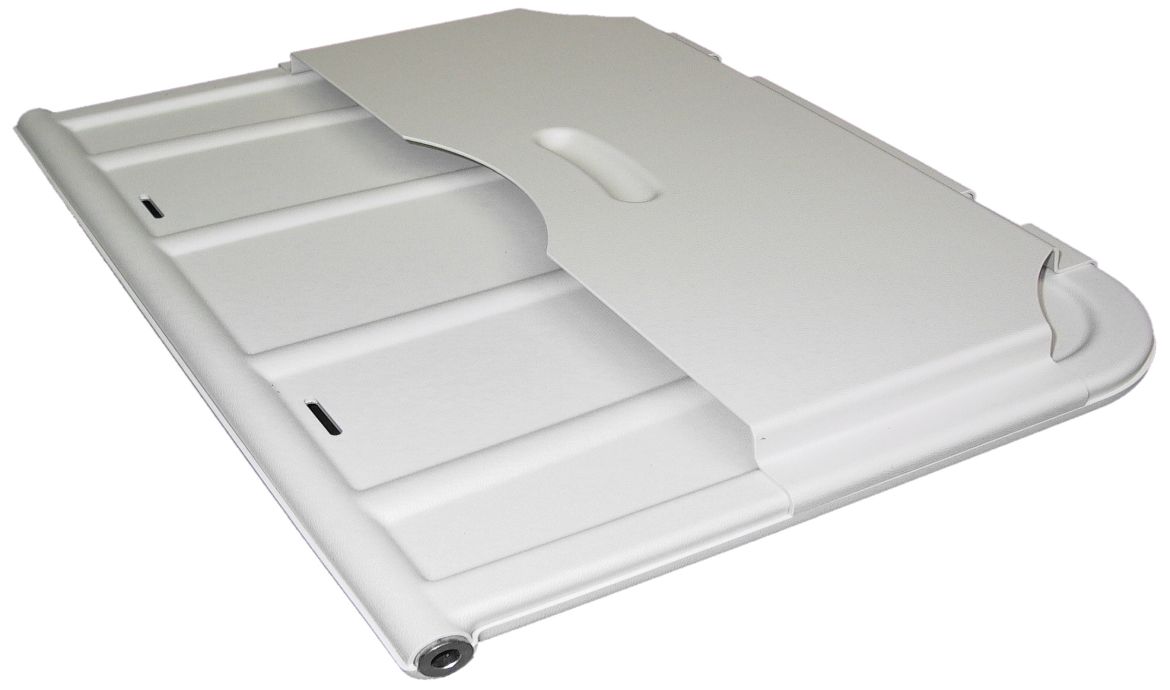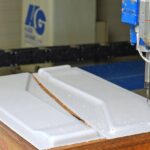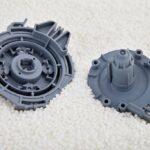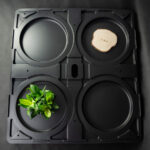The medical industry is one of the most demanding. After all, every component used in diagnostic equipment, emergency vehicles or hospital furniture must meet strict requirements for durability, chemical resistance, fire safety and sterility preservation.
Traditionally used materials that include metal, laminates and fiberglass, among others, have certain limitations. They are heavy, relatively expensive and difficult to process, and this significantly hinders the design of ergonomic shapes. The answer to these challenges is the use of plastic thermoformed parts.
Exactly what thermoformed components are most commonly used in medicine today? Find the answers in the following post!

In what areas of medicine are thermoformable components used?
In practice, thermoformable plastics are proving their worth in medicine practically everywhere where lightweight, durable and easy-to-disinfect components are needed. Today, thermoformable components are used both in diagnostic equipment (for example, in the housings of CT scanners or MRI scanners) and in ambulance bodies, where not only strength, but also low weight and ease of cleaning are important.
More and more hospital furniture manufacturers are opting for tops, headrests or dialysis seats made of thermoformed plastics. Why? Because in addition to durability and resistance to chemicals, we can make them into any shape - with smooth edges, integrated handles or special ribbing for wiring. This is a huge convenience in the daily use of medical equipment, which affects not only functionality, but also aesthetics.
The same is true for hygiene infrastructure. Thermoformed wall panels for cleanrooms, hand disinfection station covers or protective partitions should have a smooth, non-porous surface that can withstand frequent washing and strong disinfectants. Thanks to thermoforming, such items can be made extremely quickly, are fully customized to the customer's individual design and comply with the required hygiene and fire standards.
Thermoformable components in medicine today are mostly:
✅ Enclosures for diagnostic equipment - CT scanners, MRIs, ultrasound and X-ray machines, mammograms, and security booths in radiology labs.
✅ Equipment for ambulances and emergency vehicles - ambulance interior builds, ceiling and wall panels, control panels, medical equipment holders, drug shelves and cabinets, and germicidal lamp covers.
✅ Hospital and rehabilitation furniture - hospital and surgical beds, bedside tables, headrests and armrests, dialysis seats, wheelchair components and patient transporters.
✅ Medical device components - housings for ventilators, defibrillators, infusion pumps and medical suction units, control panels, cable and wire covers, and touch screen covers.
✅ Hygiene infrastructure - walls and panels in cleanrooms, hygiene panels in operating rooms, protective partitions, hygiene booths, hand disinfection stations, medical waste containers and air filter covers.
In practice, it's about more than material or technology. It's about creating components that are safe, functional and simply well designed. Such components support the work of medics every day and improve patient comfort. And this is what makes thermoforming in medicine today a standard, not just an alternative.
What does it mean that thermoformed parts are vacuum-formed?
Vacuum thermoforming is a process in which plastic sheets are heated to a suitable temperature and then formed into highly elastic states using vacuum. This makes it possible to precise reproduction of the shape of the mold and obtaining components with complex geometries and high aesthetics. Read more about the thermoforming process in our article: Thermoforming - process and application
Vacuum allows the creation of lightweight and durable components with complex shapes, ideal for medical equipment. With this technology, it is possible to design housings and components with ergonomic details, ribbing for wiring or integrated handles, improving convenience for staff and patients. For the medical industry, vacuum thermoforming is a cost-effective alternative to injection molding and laminates, especially for short and medium runs.
Key material requirements for the medical industry
It is worth noting that materials used in medicine must meet a number of stringent requirements to ensure patient safety and staff comfort. First and foremost, antimicrobial properties count. Ease of cleaning is also essential, so plastics with a smooth, non-porous surface resistant to dirt and easy to disinfect are preferred. Chemical resistance to disinfectants and detergents is also important, as well as fire resistance, complying with UL 94 (V0, 5VB, 5VA) and ECE R118 standards for ambulance applications. Materials should have high mechanical resistance to withstand impacts and scratches, and provide aesthetics and ergonomics, which is important in diagnostic equipment, rehabilitation equipment or hospital furniture.
What is most important when choosing materials for medical applications?
Choosing the right material is a key stage in the design of medical components. It should take into account both safety and hygiene requirements, as well as practical aspects such as durability or ease of processing. Below are the most important criteria that determine whether a material will perform well in a medical environment:
✅ Antibacterial
Materials should reduce microbial growth, for example, through additives with silver or copper ions.
✅ Ease of cleaning
Smooth, non-porous surfaces make it easy to disinfect and maintain hygiene.
✅ Chemical resistance
Plastics must withstand disinfectants, detergents and alcohols.
✅ Fire resistance
Required compliance with standards such as UL 94 V0, 5VB, 5VA or ECE R118 in medical transportation.
✅ Mechanical resistance
The material should be resistant to impacts, scratches and pressure under heavy use.
✅ Aesthetics and ergonomics
High-quality finishes and the ability to design ergonomic shapes enhance patient and staff comfort.
Recyclability and sustainability aspects are also playing an increasingly important role in the medical industry. The materials used in thermoforming fit perfectly into these trends, as many of them are recyclable, and the process itself makes it possible to use coextruded sheets with a recyclate layer inside and an aesthetic, hygienic outer layer.
What thermoforming materials work best in medicine?
Various thermoformable plastics are used in medicine. Below are the most commonly chosen materials and their key properties:
✅ ABS (FR)
Properties: fireproof, chemical resistant, easy to mold.
Applications: medical equipment housings, ambulance dashboards.
✅ ASA/ABS
Features: material with UV resistance and aesthetic surface finish.
Application: exterior components of emergency vehicles.
✅ PC/ABS
Properties: it is characterized by high impact strength and heat resistance.
Application: housings for CT scanners, MRIs, ultrasounds.
✅ PETG
Properties: transparent material with high impact strength, although with lower fire resistance.
Application: covers, protective barriers.
✅ PVC
Properties: naturally antibacterial and flame retardant, easy to clean.
Application: hygiene panels, cleanroom equipment.
✅ HIPS with additives
Features: an economical choice for auxiliary applications.
Application: medical furniture components, auxiliary housings.
Examples of medical components made by vacuum thermoforming in Geo Globe Poland - lightweight, easy-to-disinfect hospital furniture tops and panels, and technical covers that meet strict hygiene and safety standards.
How to choose the best thermoformed solutions for medicine?
Vacuum thermoforming is a solution that perfectly fits the needs of modern medicine. Thanks to this technology, it is possible to create components not only in large quantities, but also in unit production or short runs - quickly, cost-effectively and without compromising quality. Importantly, thermoformed components are easy to service and replace, which is of great importance in the daily work of medical facilities.
If you are looking for thermoformed components for your medical projects, at Geo Globe Poland you will find not only proven materials and technological experience, but above all specialists who understand your needs.
Our team will help you select solutions that are safe and fully adapted to the medical industry. Contact us and together we will create a project that will realistically facilitate your work and increase the comfort of your patients.
Do you have a design challenge? Contact our team - we will advise and propose a solution tailored to the conditions of your project.
Follow us on social media
You may also be interested in:
- Understanding CNC machines: What should you know about their operation and benefits?Is it possible to produce quickly, precisely and without any worries about repeatability? CNC machines make what used to require the hand of a master and many hours of adjusting, happen today in an automated, controlled and predictable way. After all, CNC machines work on projects where accuracy to tenths of a millimeter counts, as well as full control over every stage of machining. But how does this technology actually work, and why should it be used in the production of plastic components?
- The use of plastics in industryDo you know what the bottle of the iconic Family Shampoo has in common with the engine cover on a Tesla Model 3? Well, more than you might expect. Plastics today play a key role in modern industrial processes - from everyday objects to high-tech components used in automotive, aerospace and construction. Their versatility and innovation are second to none. ...
- Plastic Moldings and Thermoformed Extrusions: Advantages and Applicability in Various IndustriesIt's hard to find an industry today that doesn't need a precision-engineered, lightweight yet durable plastic component. From delicate blisters in pharmaceuticals, to transport trays on automotive lines, to ESD anti-static extrusions to protect electronics during manufacturing and logistics, thermoformed extrusions are popping up everywhere.
- Vice President Dobrochna Kochanska an official member of the Business Center ClubVice President Dobrochna Kochanska an official member of the Business Center Club

















